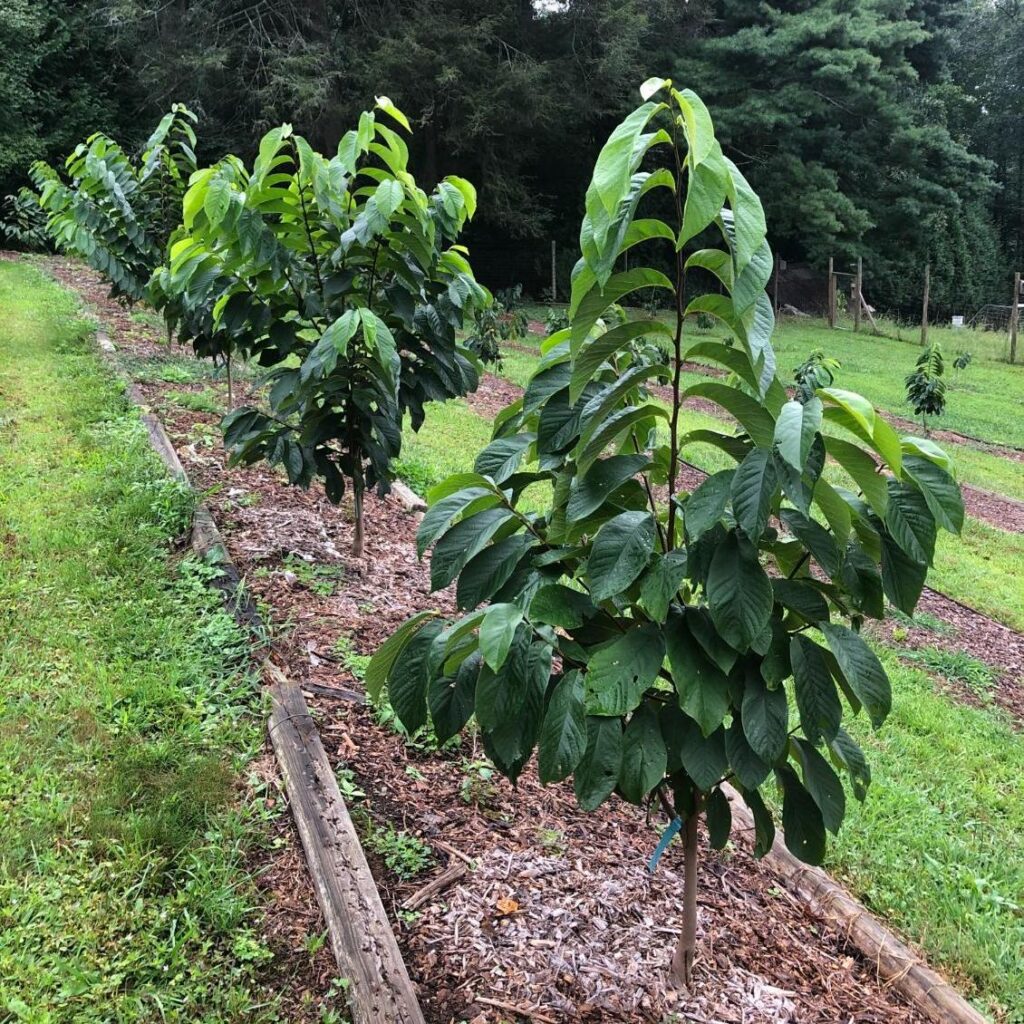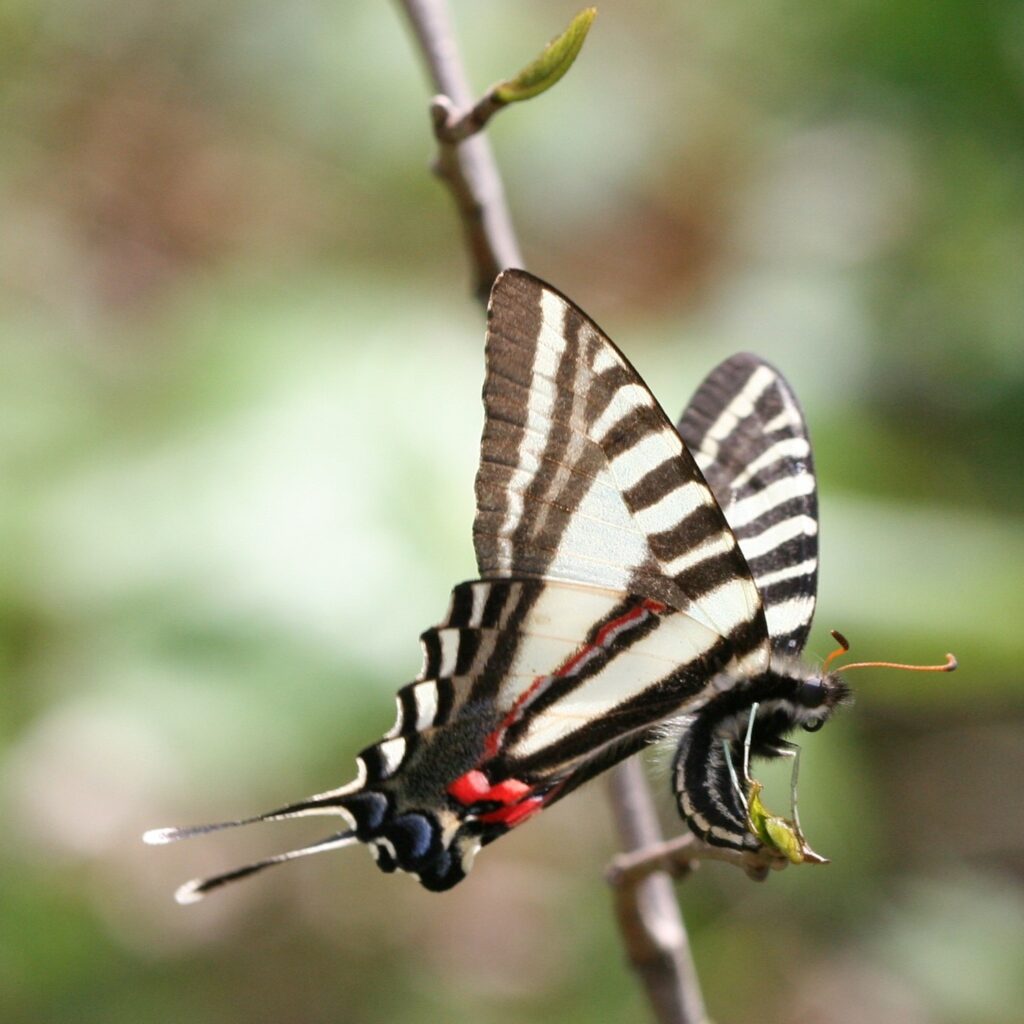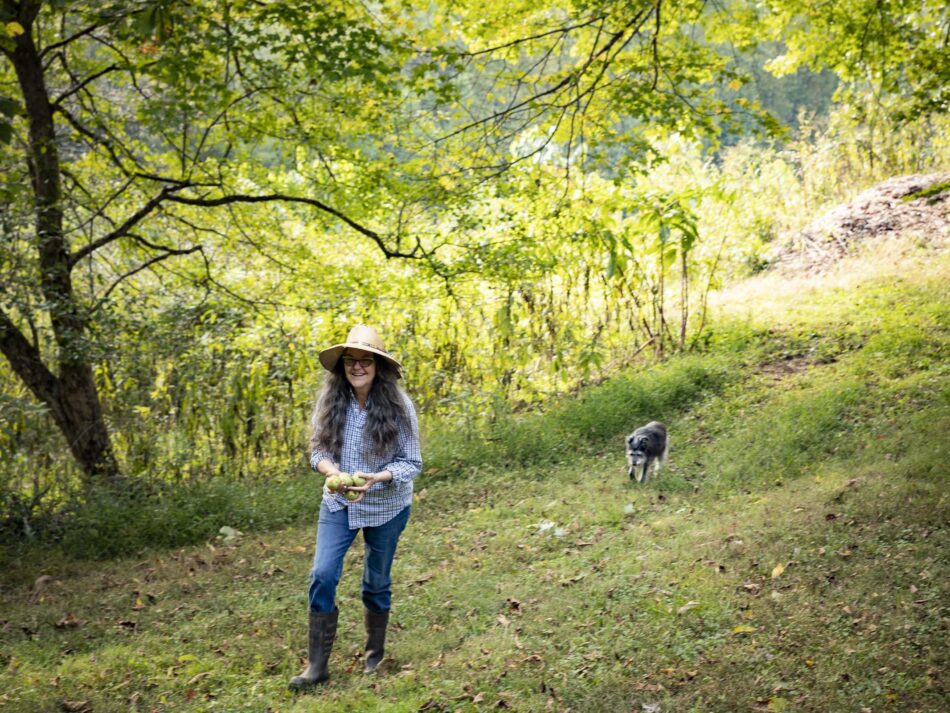Susan Owen’s mother learned “The Pawpaw Patch,” an Appalachian folk song, at a summer camp in the Ozarks in the 1930s. Later, when growing up in northwest North Carolina, she and her family would sing it together and act out the lyrics: “Where oh where is pretty little Susie? Way down yonder in the pawpaw patch. … Pickin’ up pawpaws, puttin’ ’em in her pockets.”
“And I asked her, ‘Mom, what’s a pawpaw?’” Susan remembers. “And she said, ‘I don’t know.’”
Susan, who grew up to become an organic farmer, wouldn’t discover what a pawpaw was for many years. But today, she’s among a handful of North Carolina farmers who cultivate and promote the uniquely North American fruit.
Native Americans, including the Algonquin, Haudenosaunee, and Natchitoches, cultivated and ate pawpaws for centuries. The fruit was such a staple that the Shawnee calendar included a pawpaw month, and the name Natchitoches translates to “pawpaw eater.”
Spanish explorers found the fruit soon after their arrival in the Southeast in the late 1500s. The name “pawpaw” was born of confusion; they’d mistaken the fleshy orange fruit for papaya. Just as it had nourished tribes, pawpaws became an important source of nutrients and nutritional variety for settlers and enslaved people. The entrances to their cabins were often marked with pawpaw trees.
The fruit, part of the custard apple family, never quite outgrew its association with poverty. During the Great Depression, it was called “the poor man’s banana.” In the 20th century, tropical fruits like pineapples and mangos dazzled Americans and took over supermarket shelves, but pawpaws — which must be harvested when ripe, have a short shelf life, and don’t travel well — never made the same splash. They kept growing, though, as they always had, along creeks and rivers in the Appalachian woodlands, a sweet secret in the understory.
Susan’s journey as a pawpaw farmer began at a seed swap in the late ’90s. A fellow farmer had some tiny seedlings, and when he told Susan they were pawpaws, she said she’d take one. He told her she needed two for cross-pollination.
“Well,” she told him, “I’ll take three.”
She planted them on her farm near Boone, N.C., outside a cabin she rented out. The trees matured, and their bean-shaped fruit baffled guests. They tried to feed them to the horses, who would have none of it. The problem, Susan discovered, was that the fruit wasn’t ripe. They were hard as rocks. She realized she needed to learn more about this mysterious bounty.
Susan eventually called her food broker, who helps market and sell her produce, and asked if he was interested in pawpaws. To her surprise, he was thrilled.
Susan remembers her first taste of pawpaw. ‘I couldn’t believe how delicious it was. I was shocked. I had never eaten anything that good before, ever.’
“‘I’ll take everything you have,’” Susan remembers him saying. Afterward, she turned to her husband and said, “See? Money does grow on trees.”
By 2017, her trio of pawpaw trees had become an orchard of 60.
Three years later and a few hours south, outside of Asheville, Andra Nus also started an orchard. The North Carolina State University plant breeder was homebound with a knee injury during the pandemic. She’d been working with pawpaws and, while she recuperated, read Andrew Moore’s book Pawpaw: In Search of America’s Forgotten Fruit. Around the same time, a huge hemlock in her yard came down and created a sunny patch, ripe for opportunity.
Both Susan and Andra negotiated challenges. As a farmer for 40 years, Susan was used to drying and saving seeds. The strategy didn’t work for pawpaws, whose seeds must remain moist and refrigerated to remain viable. She lost her whole first crop. Her first three trees had grown from wild pulp, but she learned that grafted pawpaw varieties tend to yield sweeter, bigger fruits with fewer seeds.
Grafting pawpaws “takes time and patience,” Andra says. “You can only graft so many in a season, and you have to have good understock. It’s a niche market.”
The combination — breeding, cultivating, and growing — played to Andra’s strengths and interests. Her patience is about to pay off; she’s expecting her first harvest this fall.
Pawpaw orchards have advantages, too. For Susan, who will turn 70 next year, cultivating pawpaws is less labor-intensive than growing vegetables. Unlike fruits like apples, they’re not as susceptible to disease, and she doesn’t have to use herbicides or pesticides on them. The fact that pawpaws have thrived here for centuries smooths the way for farmers.
“They’re native,” Susan says. “I mean, they’re going to grow, right?”




Her orchard has provided an unexpected boon, too — for butterflies. Susan explains that pawpaw trees are the exclusive breeding environment for the zebra swallowtail, a rare butterfly native to the southeast. The striking species is rarely found far from the fruit trees.
“In our area, there’s not a documented sighting of a zebra swallowtail butterfly,” Susan says. “But I’ve seen them on my farm.” Once, one flitted and swooped around her three times before vanishing back into the trees.
Susan remembers her first taste of pawpaw. “I couldn’t believe how delicious it was. I was shocked. I had never eaten anything that good before, ever,” she says. When people ask her what pawpaw tastes like, and they often do, she tells them it tastes like heaven. It’s tricky to put the flavor of a fruit into words, but Susan tries; she describes it as a cross between mango, banana, and pineapple, with a touch of caramel. “It’s very tropical tasting,” she says.
No wonder her food broker was so excited. A local brewery found out she had pawpaws and touched off a sort of bidding war with a food wholesaler who was also interested in her crop. The brewery won (and made pawpaw beer).
Andra, too, hopes to sell to breweries, which can use large quantities and take advantage of pawpaws’ fleeting shelf life and short season. Many farmers markets ask farmers to commit to a whole season, impossible for farmers whose harvest lasts only a couple of weeks.
Farmers like Andra and Susan and their customers — chefs, brewers, and individuals — are fueling a pawpaw revival. Every September, at the height of pawpaw season, Susan packs up her fruit and drives to Winston-Salem for the annual North Carolina Pawpaw Festival.
There, farmers will swap seedlings, recipes, and growing tips, and many festival-goers will sample pawpaw, that taste of heaven, for the first time. They’ll try pawpaw foods and drinks, and learn about the long history of one of North America’s few native fruits. Andra and Susan will sell not only their crop but grafted trees, too. Some have asked Susan why. Won’t selling trees cut into her market?
“I’m like, ‘Does growing an apple tree in your backyard cut in on the apple market?’” she says with a laugh. “I would much rather everybody had pawpaws in their backyard.”
Making Pawpaw Ice Cream
One of Andra’s favorite things to do with pawpaws is make ice cream. “Pawpaw goes really well with dairy products like yogurt and milk,” she says. “Something about that combination of tropical fruit in a smoothie or ice cream is just really, really yummy.” Her simple recipe is a mixture of 2 cups each of pawpaw purée, milk, and cream, and 1 cup of sugar that she freezes in an ice cream maker.
Description
Tropical-tasting and subtly spiced, pawpaw jam isn’t yet synonymous with fall — but its day is coming. Pawpaws are the largest native fruit in North America, and they taste like a combination of banana, coconut, and mango with a hint of something floral thrown in. A longtime Indigenous food source and the subject of at least one folk song, these fruits ripen in the eastern half of the U.S. between late August and October, and are mostly sold by foragers and small-scale farmers. (So sniff ’em out at a pawpaw festival or order ’em online if you don’t have a tree growing near you.) Pawpaws’ floral flavor is destroyed by high heat and long cooking, so this quick jam preserves it by cooking just long enough for the sugar and fruit to gel.
- Cut the pawpaws in half, scoop out the flesh, and remove the seeds. Mash the resulting pulp with a fork until it’s fairly even in consistency.
- Combine the pulp, sugars, lemon juice, nutmeg, and salt in a medium saucepan and cook over medium heat until the mixture reaches a strong simmer.
- Reduce the heat to medium-low (or just high enough to keep it at a gentle simmer) and cook, stirring frequently, until some of the water has reduced and the mixture has just begun to gel, about 7 to 10 minutes.
- Allow the jam to cool to room temperature before using. Store in the fridge and use within two weeks.
Notes
- If you can’t find pawpaws near you, I recommend buying through Foraged.com.
- Pawpaws can vary in size from being similar to lemons or mangos, so based on the size of yours, you may need to adjust the quantity or have leftovers.
This recipe originally appeared on Pale Blue Tart: The best fall fruit you’ve never heard of.






